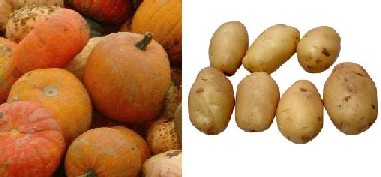I have tried a few garden plants at different places, please adapt my experience to your space & location.

Image Courtesy: homegrownwisconsin.com
Tomato/Coriander/Tulsi/Green Beans/Ginger/Turmeric/Yam/Guvar/Chilli – All these respond well to Indian weather conditions, and as long as you provide some sand in a pot, and get good amount of sun-light they yield good results without much pest attacks. Green beans, Guvar, Chilli and Tomatoes should be planted 2 months before summer.
Cabbage, Cauliflower, Lettuce, Potatoes: Grows well in cool climate only. Need loamy and wet soil. Need protection from frost and hail, best to be grown 3-4 months before summer.
Curry leaf, Plantain, Lemon, Sweetlime – Need clay type soil, with some amount of sun-light, but easy to take care. Plant it before rainy season, to reduce your work.
Bittergourd, Snakegourd, Sweetpotato, Grapes – All these are climbers, that grow quite well in Indian conditions. For Grapes, pick local varieties for pest resistance. Snakegourd needs a horizontal mesh, while the rest can take up vertical or horizontal mesh. You can harvest 3-5 kgs of grapes with a single plant, that can be raised in a 1sqfeet land-space. However grapes, like pepper needs additional plants in the vicinity as they need some level of ground cover near their roots. Other than grapes and pepper , other plants have to be planted soon after the rainy season, so that they start yielding in Spring and Summer. You can choose late spring planting too, but you may spend more water.
Roses, Groundnuts, Karamani (black eyed white peas), Leek, Radish, Onions – Respond well to loamy, red-soil. In fact all the potted plants on the first line can be raised on this kind of land. Groundnuts need to be harvested shortly after their flowers start withering. Good to plant them shortly after the rainy season.
Pumpkins & Potatoes – If you do Vermi composting (organic wastes from the kitchen with live earthworms and sand), you can throw any seed on it and can be assured that you can get a healthy sapling. Note that healthy saplings replanted elsewhere have a 80% higher success rate than direct sowing. Anyway vermi composting locations are as such good places to plant pumpkins, and all you need to do is direct the climber to your nearest terrace or shed, and you will see lots of pumpkins. In villages pumpkins thrown over rubble has seen 30-40 pumpkins within 3-4 months, provided the weather is cooperative (plant towards the end of the rainy season, so that harvesting happens around spring time to early summer).

Image Courtesy : Google Images
There should be more vegetables and fruits, you may want to try for your kitchen garden.




